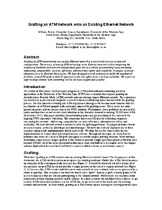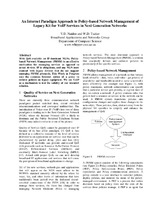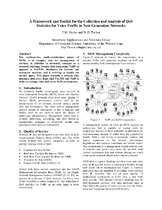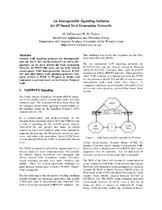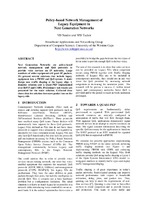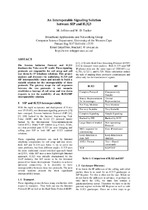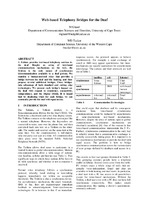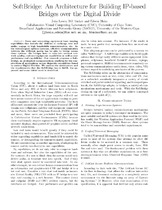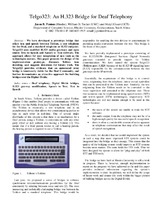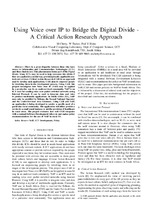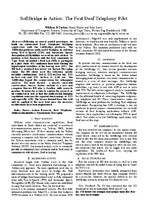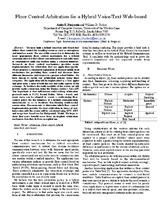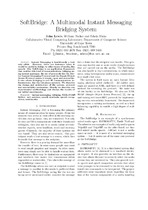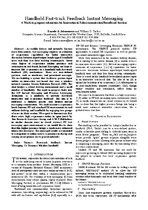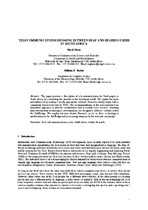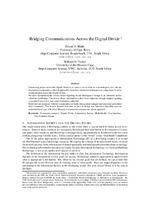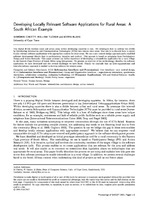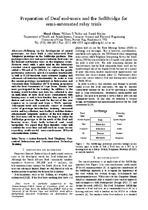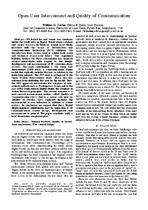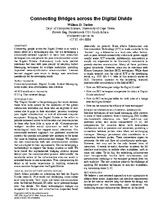Browsing Prof. William Tucker by Issue Date
Now showing items 1-20 of 89
-
Grafting an ATM network onto an existing ethernet network
(Telkom, 1998)Grafting an ATM network onto an existing Ethernet network is a non-trivial exercise in network configuration. The process of mating ATM technology to an Ethernet network without tampering the underlying backbone and network ... -
An Internet paradigm approach to policy-based network management of legacy kit for VoIP services in Next Generation Networks
(Telkom, 2000)With QoS available on IP-dominant NGNs, Policy-based Network Management (PBNM) is an effective mechanism for managing services as opposed to actual devices. IP is ubiquitous, and any NGN must contend with legacy devices ... -
A framework and toolkit for the collection and analysis of QoS statistics for voice traffic in Next Generation Networks
(Telkom, 2000)The multi-service, multi-architecture nature of NGNs is so complex that the management of services, in addition to networks, emerges as a research challenge. Despite QoS limitations, VoIP (as opposed to VoATM), dominates ... -
An Interoperable signaling solution for IP-based Next Generation Networks
(Telkom, 2000)Current VoIP signaling protocols are interoperable with the PSTN SS7 via H.323-to-SS7 or SIP-to-SS7 gateways. As we move toward the Next Generation Network, the PSTN falls away and we work toward carrier-grade VoIP ... -
Policy-based network management of legacy equipment in Next Generation Networks
(Telkom, 2001)Next Generation Networks use policy-based network management and QoS protocols to provide voice services on IP networks. Large numbers of older equipment still push IP packets. We present several solutions that include ... -
An interoperable signaling solution between SIP and H.323
(Telkom, 2001)The Session Initiation Protocol and H.323 dominate the Voice over IP world. These signaling protocols are responsible for call setup and call tear down by IP telephony solutions. This project analyses and discusses the ... -
Web-based telephony bridges for the deaf
(Telkom, 2001)A Teldem provides text-based telephony services to the deaf. Despite an array of text-based communications mechanisms on the web, the Teldem is the only means of synchronous telecommunication available to a deaf person. ... -
SoftBridge: an architecture for building IP-based bridges over the digital divide
(Telkom, 2002)Users and computing equipment have varying capabilities that include the abilities to exchange text and audio, engage in high bandwidth communication, etc. As the technological options increase, e ective communication ... -
Telgo323: an H.323 Bridge for deaf telephony
(Telkom, 2002)We have developed a prototype bridge that relays text and speech between Teldem, a text telephone for the Deaf, and a standard telephone or H.323 endpoint. Telgo323 uses modified H.323 media gateways and open source Text ... -
Using voice over IP to bridge the digital divide: a critical action research approach
(Telkom, 2003)There is a great disparity between those who have access to Information and Communication Technologies (ICTs) and those that do not. This phenomenon forms part of the Digital Divide. Many ICTs may be used to help overcome ... -
SoftBridge in action: the first Deaf telephony pilot
(Telkom, 2003)Following on several partial prototypes, we built an automated Deaf Telephony bridging application with the SoftBridge platform. The SoftBridge performs multi-modal bridging in real-time using Text-to-Speech (TTS) and ... -
Floor control arbitration for a hybrid voice/text web-board
(Telkom, 2003)We have built a hybrid voice/text web–board that utilizes floor control for handling resources such as microphone and interface events. The aim of this research is to determine the most appropriate floor control mechanism ... -
SoftBridge: a multimodal instant messaging bridging system
(Telkom, 2003)Instant Messaging is traditionally a text only a air. However, there are instances when it would be useful to bridge to other types of media, like speech. The SoftBridge is an application framework that enables this kind ... -
Handheld fast-track feedback instant messaging
(Telkom, 2003)As mobile devices and networks become more data-centric, text messaging requires an extension of co-presence capabilities for better interactive discussion between input/output handicapped handheld users and their free ... -
Telecommunications bridging between deaf and hearing users in South Africa
(2004)This paper presents a description of telecommunications for Deaf people in South Africa by contrasting the situation in the developed world. We explain the main motivations for providing a locally appropriate solution. ... -
Bridging communications across the digital divide
(CTIT, 2004)Connecting people across the Digital Divide is as much a social effort as a technological one. We are developing a community-centered approach to learn how interaction techniques can compensate for poor communication across ... -
Developing locally relevant applications for rural areas: a South African example
(SAICSIT, in assocation with ACM, 2004)The digital divide between rural and urban areas within developing countries is vast. We investigate how to address this divide by introducing Information and Communication Technologies (ICTs) into remote rural areas. Our ... -
Preparation of Deaf end-users and the softbridge for semi-automated relay trials
(Telkom, 2004)Following on the development of several prototypes, we have built a semi-automated Deaf Telephony prototype on the SoftBridge platform. This prototype relays text and speech between Deaf users on the Internet and hearing ... -
Open user interconnect and quality of communication
(Telkom, 2004)We looked for and found two situations within the South African Digital Divide where constant and severe macro-scale latencies would most likely interfere with the usage of Information and Communication Technology (ICT) ... -
Connecting bridges across the digital divide
(ACM, 2004)Connecting people across the Digital Divide is as much a social effort as a technological one. We are developing a community-centered approach to learn how interaction techniques can compensate for poor communication across ...

